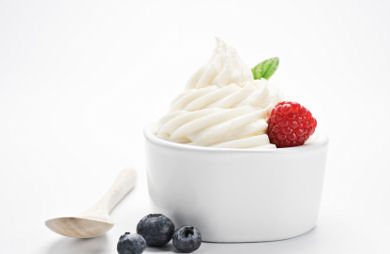|
It's safe to say that the frozen yogurt trend has taken the US by storm—and it doesn't show any signs of stopping. Several ''FroYo'' franchises have cropped up over the past few years, including Pinkberry, Red Mango, Orange Leaf, and many others with tasty names and even tastier flavor and topping offerings. Some of these yogurt shops claim that their product is a healthier alternative to ice cream, made with ''all-natural,'' wholesome ingredients, including good-for-you probiotic cultures to balance your digestive system. But can you believe the hype? Between two big-name frozen yogurt chains, Pinkberry and Red Mango, which has the most ''natural'' yogurt with the fewest ingredients? The Winner: Red Mango!  Here are the ingredients lists for the Original (''tart'') flavor of yogurt for both chains: Pinkberry: Nonfat milk, sugar, nonfat yogurt (pasteurized nonfat milk, live and active cultures), nonfat yogurt powder (nonfat milk, culture), fructose, dextrose, natural flavors, citric acid, guar gum, maltodextrin, mono- and diglycerides, rice starch Active live cultures: s. thermophilus, l. bulgaricus, l. acidophilus. 100 calories per half a cup 20 grams of sugar (Source: pinkberry.com) Red Mango: Nonfat Yogurt (Skim Milk, Natural Flavor, Guar Gum, Live & Active Cultures), Filtered Water, Pure Cane Sugar, and less than 1% of Sodium Citrate and Potassium Citrate (natural buffering agents). Active live cultures: S. thermophilus, L. bulgaricus, L. lactis, L. acidophilus, and GanedenBC30® (Bacillus coagulans GBI-30, 6086) 80 calories per half a cup 19 grams of sugar (Source: redmangousa.com) Notice that besides plain old yogurt, Pinkberry also includes added milk, powdered yogurt, and sugar, while Red Mango only contains nonfat yogurt. Additionally, Pinkberry's yogurt contains three types of sugar--plain sugar (the second ingredient), fructose and dextrose, whereas Red Mango's ingredients simply list ''pure cane sugar." These differences can be seen in the slightly higher sugar content on the Pinkberry label. Pinkberry's yogurt also contains mono- and diglycerides, which are used as thickeners and can be made either synthetically or naturally. Finally, Pinkberry's yogurt contains guar gum and rice starch for additional thickening agents, and Red Mango only uses guar gum. As far as those good-for-you probiotics, Red Mango's yogurt includes five active live probiotic cultures as compared to three in Pinkberry's yogurt. Keep in mind, though, that there is still more research to be done on the effectiveness of probiotics, and it's possible that some of the cultures could die during the freezing process, so don't start self-medicating with frozen yogurt every time you have a stomachache! However, despite its mostly superior stats, Red Mango isn't perfect: note that both yogurt chains include ''natural flavor'' in their ingredients lists, which can really mean any number of things since the FDA doesn't exercise any regulation over the phrase. Red Mango's yogurt also still contains a lot of sugar (19 grams, which is equal to nearly 5 teaspoons!) and almost twice the sodium of Pinkberry's yogurt (50 mg vs. 110 mg). But overall, if you're looking for a sweet, nonfat treat with a shorter ingredients list and fewer calories to boot, stick with Red Mango—just go easy on the toppings and choose fresh fruit and nuts over sugary candies and syrups. For more information on frozen yogurt and other creamy frozen treats, check out this fun video! Do you FroYo? What's your favorite FroYo chain? |
More From SparkPeople
|



.jpg)





.jpg)










